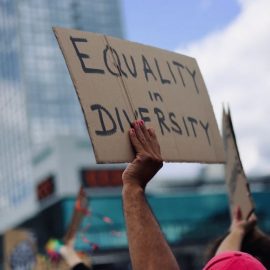

This article is an excerpt from the Shortform book guide to "Radical Acceptance" by Tara Brach. Shortform has the world's best summaries and analyses of books you should be reading.
Like this article? Sign up for a free trial here .
What is a bodhisattva in Buddhism? How can you work to rid yourself of feelings of otherness? Why is it so important to expand your group?
In Buddhism, a bodhisattva is someone who could enter Nirvana, but chooses to stay on Earth and help others reach it instead. While it would be difficult for most of us to start making sacrifices for others, we can still work to be more compassionate and to eliminate the lines between “us” and “them.”
Continue on to learn more about bodhisattvas and selflessness.
Compassion and the Bodhisattva
Compassion grows in circles. For example, we might start by finding compassion for our closest friends and family. From there, we could expand our compassion to include people we see, but may not know very well: Our friends’ parents, for example, or the people we regularly see at the gym or in classes. In embracing compassion, we might start to recognize how many people around us suffer with the same fears, insecurities, and pain that we do. That is the first step to becoming a bodhisattva.
The final step is extending your awareness and compassion without limit—caring for everyone who’s suffering anywhere in the world, everyone who feels alone and afraid. This kind of awareness and compassion helps us as well; it reminds us that there’s nothing wrong with us when we feel hurt or scared; it’s simply part of being human.
In Buddhism, a bodhisattva is someone who could enter Nirvana (paradise), but chooses to stay on Earth and help others reach it instead. A bodhisattva is the embodiment of selflessness: Someone who forgoes ultimate happiness in order to help others find it. While many of us may not have the chance to enter Nirvana in our lifetimes, we can aspire to similar levels of compassion by continually growing our own circles.
The Illusion of the “Other”
When we’re caught up in our own stories, everyone else tends to become “other.” They seem separate from us, different, not quite real. We start assigning them roles, as if they’re characters in a show: Some are allies, some are enemies, and most of them don’t matter to us at all.
The more different people seem from us, the less real they tend to feel. It becomes easy to dismiss anyone of a different race, religion, or socioeconomic background. We focus on superficial aspects of people and assign them labels.
Those labels could be complimentary, like “star,” or even “hero.” However, they can also be derogatory, like “bum,” or “alcoholic.” Sometimes the labels are less concrete and more to do with behavior, like “boring,” “needy,” or “pushy.” By labeling people this way, we make it easier to view them as other.
Once we start seeing someone as a label, and not a real person with real feelings, we don’t consider their pain anymore. At this point we don’t just ignore them; we can hurt them without feeling anything ourselves. This method of other-ing people is what leads a father to disown his gay son, or a patriot to cheer when people on the other side of a war die.
Expand Your Group
This sense of “other” has its roots in biology. We’re programmed to look for members of our own group and shun those who look, or act, or even smell different. These habits used to help us keep ourselves and our relatives alive, and it’s a powerful instinct even in modern times.
However, it’s possible to lower our defenses. We can expand our idea of what our “group” is, enlarging it in the widening circles we discussed before. Doing so is another type of Radical Acceptance—accepting others as they are, without inventing stories or passing judgment. This is also key to feeling compassion like a bodhisattva does; a bodhisattva sees the entire world as his or her group.
There’s an old Sikh story that demonstrates what it means to see everything—not just all humans, but all living things—as real. In the story, an old master calls his two most faithful students to attend him. He gives each of them a chicken, and tells them to go someplace where nobody can see them and to kill the chicken.
One student immediately obeys. He goes behind a shed and slaughters the bird. The other walks around for hours, and eventually returns with the chicken still alive. He tells the master that his task was impossible, for there was nowhere he could go that the chicken wouldn’t see. The second student saw the chicken as a real being.
Reopening Our Hearts
There will be times when even the people we’re closest to make us feel imposed upon, frustrated, scared, or disgusted. That doesn’t mean that we’re failing as compassionate beings, it just means that we need to turn our attention and our Radical Acceptance inward again. We need to understand and have compassion for our own experience. Then we can move outward and have compassion for the other person’s experience like a bodhisattva.
We may often find that our negative response toward this other person is because we’ve distanced ourselves from him or her. We may have accidentally reduced the other person to a label like “student” or “mother.” Practicing Radical Acceptance on our own reactions, and then expanding that compassion to encompass the other person, will allow us to engage with and care for that person.
Compassion for others often begins with the question “what do they need?” Practicing asking this question—both to ourselves and others—helps to get us away from our own needs and to act from a place of true compassion. For example, perhaps all someone really needs at a given moment is to be heard and understood. Someone who wants to be seen as helpful and competent might listen to that person, but then offer advice where it’s not wanted. Even if her intentions are good, she’s acting based on her needs rather than the other person’s.
However, compassion can go beyond just understanding another person’s needs. Imagining yourself in another person’s shoes is the very heart of compassion—what would it be like to inhabit that person’s mind and body, to exist in his or her circumstances?
Role Reversal
There’s a psychological technique called role reversal that’s designed to encourage this type of compassion. For example, say that a husband and wife were having marital difficulties. Role reversal would begin with one of them—perhaps the wife—describing her current experiences; how she perceives and feels about her current situation. Then the husband would pretend to be the wife, and try to speak from her perspective about those same issues. Next, the process would repeat with the focus on the husband’s experiences.
Role reversal is a formalized method of getting ourselves out of our own heads and into another person’s, as much as possible. However, we don’t have to go through that entire process every time we try to have compassion for someone else. It’s often enough to simply imagine what the other person may be thinking or feeling, and to consider how we could help.

———End of Preview———
Like what you just read? Read the rest of the world's best book summary and analysis of Tara Brach's "Radical Acceptance" at Shortform .
Here's what you'll find in our full Radical Acceptance summary :
- How to live your life fully experiencing everything
- Why you need to let go of judging yourself or your experiences
- How you can acknowledge and welcome any experience






